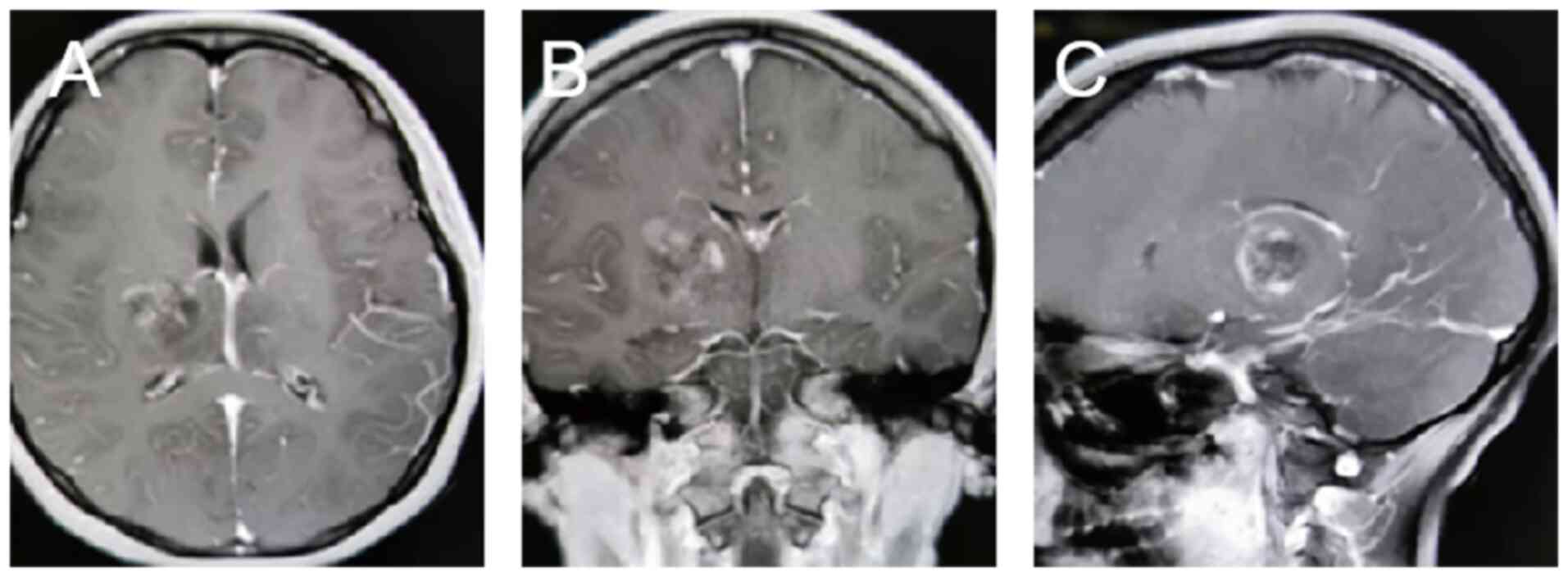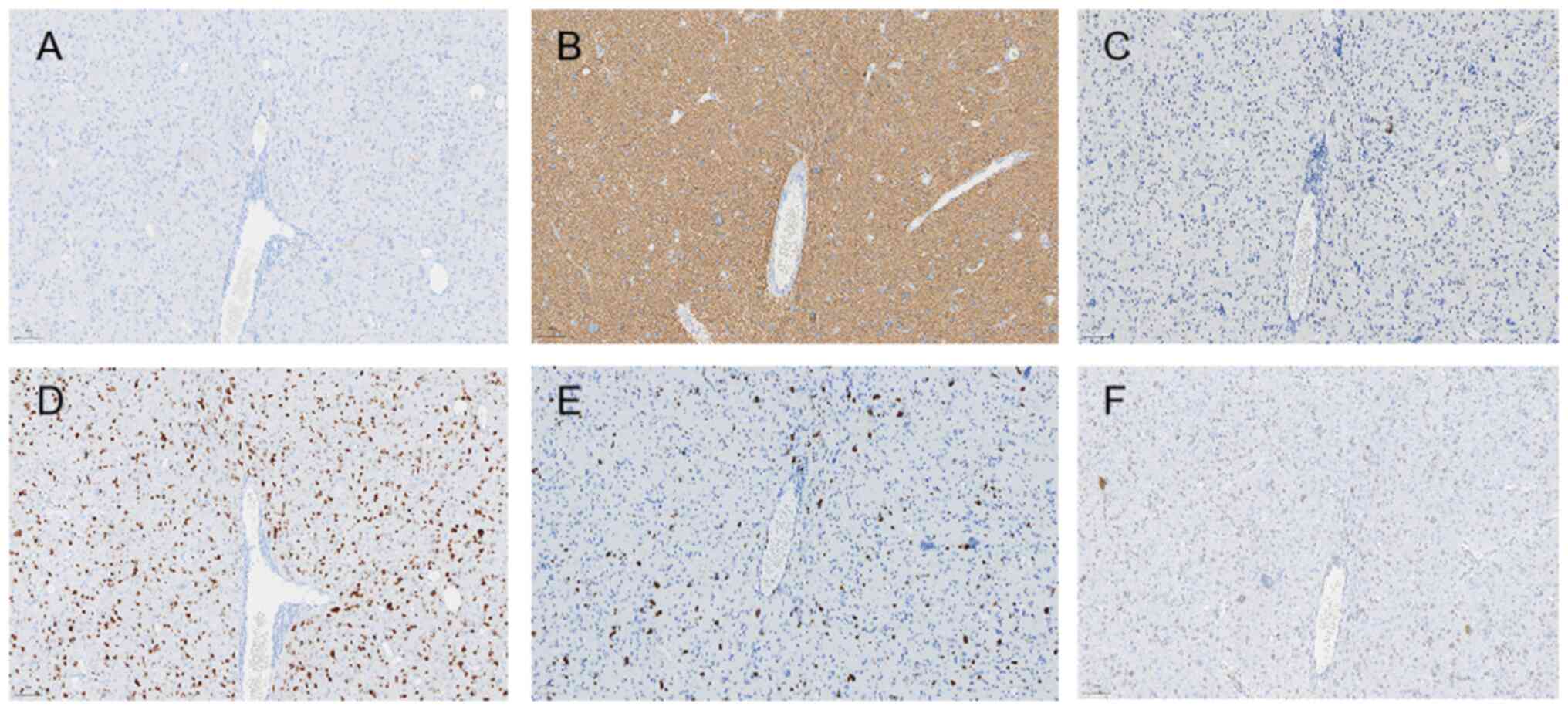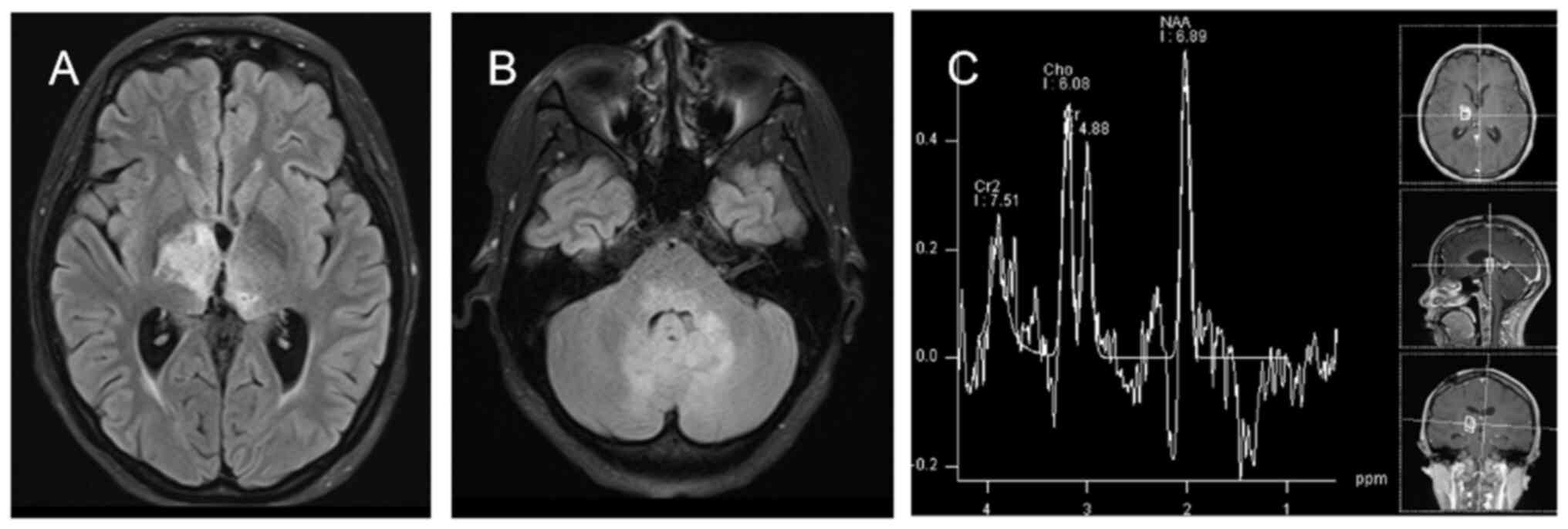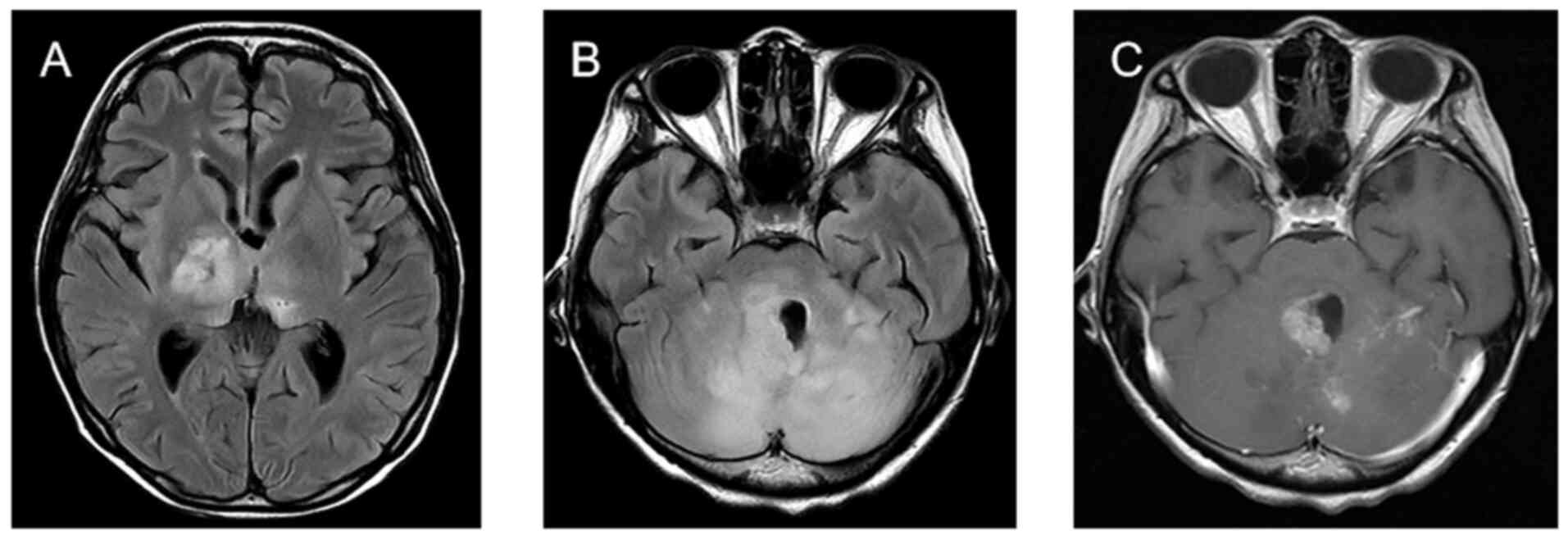Personalized combination therapy for diffuse midline glioma: A case report
- Authors:
- Published online on: March 17, 2025 https://doi.org/10.3892/ol.2025.14980
- Article Number: 234
-
Copyright: © Sun et al. This is an open access article distributed under the terms of Creative Commons Attribution License.
Abstract
Introduction
Diffuse midline gliomas (DMG) with the H3K27M mutation are primary malignant tumors located in the linear structures of the brain; according to the CBTRUS statistical report, DMG is rare in adults, with an annual incidence rate of ~0.1 cases per 1 million people, accounting for 2–3% of all gliomas in adults. H3K27M mutation is a core molecular hallmark of DMG, and >70% of patients with DMGs carry this mutation. The prognosis for this disease is extremely poor, and the mortality rate is extremely high, with a median overall survival of only 12 months for newly diagnosed patients and a 5-year survival rate of only 1% (1). Other molecular types of DMG include the EZHIP overexpression type, EGFR mutant type and H3G34 mutant type. In addition to use of conventional surgery, radiotherapy and chemotherapy, the exploration of new approaches is essential to improve patient prognosis. Currently, there are few reports on the diagnosis and treatment of H3K27M mutant diffuse midline glioma (2). In the present study, a patient with adult H3 K27M mutant diffuse midline glioma was admitted to the Department of Radiotherapy of Oncology, Shenzhen People's Hospital (Shenzhen, China) and was administered a combination of treatment strategies such as surgery, radiotherapy, chemotherapy, electric field therapy, immunotherapy and targeted therapy, which is a new innovative direction for treatment.
Case report
A 20-year-old woman presented to Shenzhen People's Hospital in September 2021 with a deviated angle of the mouth and left-sided limb dysfunction. Subsequently, a magnetic resonance imaging (MRI) examination was performed at the Imaging Department of Shenzhen People's Hospital (Shenzhen, China), which showed bilateral thalamic masses (Fig. 1). The thalamus assists in maintaining consciousness and perceptual functions. Surgical procedures can damage the structures of the thalamus, leading to complications such as impaired memory, language or motor function, and the high risk of surgery requires extra care in the surgeon's evaluation. On the recommendation of the surgeon, the patient underwent microscopic resection of the right thalamic mass. Postoperative pathology showed a DMG of the right thalamus, with H3K27M mutation, at World Health Organization (WHO) grade 4 (3). The immunohistochemistry protocol was as follows: Paraffin-embedded tissue sections were deparaffinized and hydrated sequentially in xylene, anhydrous ethanol, gradient ethanol and distilled water. The sections were then placed in EDTA antigen repair buffer, heated at 95–100°C for 20 min, cooled for 10 min and rinsed three times (3 min/wash) with PBS. Next, 3% peroxidase blocker was added at 36°C for 10 min, and the sections were rinsed three times with PBS (3 min/wash). Primary antibodies were added to the sections and incubated at 4°C overnight (12 h). Sections were then preheated at 37°C for 30 min and washed three times (5 min/wash) with PBS (cat. no. 950–300; Roche Diagnostics). A secondary antibody (horseradish peroxidase-conjugated; 1:100; cat. no. 760-500; Roche Diagnostics) was added and incubated in an oven at 37°C for 8 min, then washed three times (5 min/wash) with PBS. After removing the PBS solution, freshly prepared DAB color development solution was added and incubated for 3–5 min. After rinsing with tap water, the sections were incubated with hematoxylin stain for 10 to 30 sec, and then rinsed with PBS. Finally, the sections were dehydrated, cleared and sealed. Light microscopic examination (Leica Biosystems) demonstrated the following results: H3K27M(+) (1:100; cat. no. ZA-0321), H3K27me3(−) (1;100; cat. no. ZA-0327), isocitrate dehydrogenase 1 (IDH1)(−) (1:50; cat. no. TW-0821), glial fibrillary acidic protein(+) (1:1,000; cat. no. MX-047), p53(−) (1;100; cat. no. BPM6168), oligodendrocyte transcription factor-2(+) (1:100; cat. no. EP-112), Ki-67(+)(50%) (1;100; cat. no. BP-6045), transcriptional regulator ATRX(+) (1:200; cat. no. MX-071) (all Roche Diagnostics). O6 methylguanine DNA methyltransferase (MGMT) promoter methylation negativity (cat. no. MX-0361), and a lack of 1p/19q co-deletion (Figs. 2 and 3). At 1-month post-surgery, head MRI follow-up showed a thalamic glioma on the left side and postoperative changes on the right side of the lesion; Magnetic resonance spectroscopy (MRS) showed that MRS changes in the left thalamic lesion were consistent with the tumor lesion, and MRS around the right thalamic surgical area did not show any significant abnormality (Fig. 4).
As the tumor could not be completely removed by surgery, the patient started postoperative adjuvant radiotherapy in November 2021, following the Radiation Therapy Oncology Group principles of radiotherapy target delineation for high-grade gliomas (4). The prescribed dose for the first phase was 46 Gy/23 fractions and the prescribed dose for the second phase of treatment was 14 Gy/7 fraction. During radiotherapy, concurrent temozolomide chemotherapy (75 mg/m2, orally, after 4 h of fasting, once a day) was administered. At 4 weeks post-synchronous radiotherapy and chemotherapy, the patient entered the adjuvant chemotherapy stage and orally took 150–200 mg/m2 temozolomide daily for 5 consecutive days, repeating every 28 days for a total of 12 cycles. Notably, the treatment was combined with maintenance with tumor-treating fields (TTFields) during and after radiotherapy.
During the follow-up period, the patient underwent a brain-enhanced MRI follow-up assessment every 3 months, and the efficacy was analyzed according to the Response Assessment Criteria in Neuro-Oncology (RANO) (5). As of June 2023, the patient developed the symptom of unsteady walking, and the follow-up cranial MRI showed significant changes in the long T1 and long T2 abnormal signals in the bilateral thalamus, bilateral cerebellar hemispheres and cerebral pons (Fig. 5). Tumor progression was considered after a multidisciplinary discussion based on RANO criteria.
In August 2023, the patient was started on maintenance therapy with bevacizumab (5 mg/kg once every 2 weeks) in combination with TTFields. After 2 months, follow-up brain enhancement MRI showed a slightly larger intracranial space-occupying lesion than before (in June 2023, the size of the lesion in the thalamus was 20×17 mm, and the size of the lesion in the cerebellar hemispheres and pontine brain was 28×21 mm; in October 2023, the size of the lesion in the thalamus was 30×20 mm, and the size of the lesion in the cerebellar hemispheres and pons was 28×25 mm), indicating that the patient's disease was poorly controlled. In October 2023, the treatment regimen was changed to bevacizumab (10 mg/kg every 2 weeks) and pembrolizumab (200 mg every 3 weeks) immunotherapy in combination with TTFields. In December 2023, follow-up brain-enhanced MRI showed slow progression of the lesion. The efficacy was assessed as stable disease (SD) according to the RANO criteria. However, the patient's family wanted to achieve more effective tumor suppression, so they purchased their own targeted drugs, ONC201 (510 mg orally once a week) and ONC206 (60 mg orally once a week) (both Lindburg Pharmacy, Inc.), which are not currently indicated for use in China, and used them for personalized combination therapy with bevacizumab, pembrolizumab and TTFields in December 2023. In January 2024, a follow-up cranial MRI showed that the bilateral thalamus, dorsal pontine, cerebellar vermis and bilateral cerebellar hemispheric lesions had not changed, showing temporary control of the lesion.
In February 2024, due to aspiration pneumonia, the patient suspended the treatment of bevacizumab and pembrolizumab but still insisted on the treatment using TTFields, ONC201 and ONC206. In March 2024, the patient developed symptoms of choking on drinking water, difficulty in swallowing and weakness while coughing up sputum. In March 2024, a follow-up cranial MRI showed that the foci of the bilateral thalamus, dorsal pontine, cerebellar earth and bilateral cerebellar hemispheres had increased in size (Fig. 6) compared with the previous measurements (the size of the lesion in the thalamus was 30×20 mm, and the size of the lesion in the cerebellar hemispheres and pons was 33×29 mm), and tumor progression was considered. The patient subsequently received respiratory treatment for a lung infection, and anti-tumor therapy was suspended. The patient succumbed to respiratory failure in March 2024.
Discussion
H3K27M mutant glioma is a relatively newly discovered disease. This mutation was first reported in 2012 and typically occurs in H3.1 or H3.3 subtypes, serving as the initiating mutation in tumors (6). This mutation coexists with multiple genetic changes, but does not coexist with IDH and EGFR mutations. H3K27M mutant tumors usually have unmethylated MGMT, leading to poor efficacy of temozolomide in radiotherapy. This mutation also leads to H3K27 trimethylation loss and H3K27 acetylation increase, affecting gene expression. In 2016, the WHO classified H3K27M mutant tumors as a unique form of grade IV glioma. The updated 2021 classification has been further refined to include prognostically relevant molecular annotation for H3K27 (3,7). The H3K27M mutation is associated with poor survival rates, and affects children and young adults. Up to 90% of cases in pediatric diffuse intrinsic pontine glioma (DIPG) carry this mutation, and 15–60% of cases in adult DMG also have this mutation (8).
Radiotherapy is currently the only standard of care that temporarily relieves the symptoms of DMG, delays disease progression and prolongs median survival time (9); however, there is still insufficient evidence to determine the optimal radiotherapy target area and dose. In 2017, the Chinese consensus of experts on radiotherapy for gliomas recommended a total radiation dose of 45–54 Gy (1.8–2.0 Gy/dose). Depending on the specific circumstances (such as high malignancy), 54–60 Gy (1.8 to 2.0 Gy/dose) or 39 Gy (3.0 Gy/dose) could also be selected (10). The Korean Society of Neuro-Oncology guideline 2021.1 for adult DMGs recommends a total dose of 54 to 60 Gy, and the therapeutic target range includes 1–2 cm of tumor outgrowth for conventional segmental irradiation (11). In the present case, the patient's tumor was located in the bilateral thalamus and the tumor could not be entirely removed by surgery. Postoperative radiotherapy was the primary treatment method. Therefore, the radiotherapy plan was developed according to the RTOG high-grade glioma radiotherapy target area delineation method (4). The total dose of radiotherapy was up to 60 Gy, and the patient's whole radiotherapy process went smoothly without any prominent radiotherapy toxicities or side effects. It is well known that the high expression of MGMT in DMG with H3K27M mutation can lead to resistance to temozolomide in patients (12,13). In addition, the presence of the blood-brain barrier limits the entry of most antitumor drugs into the brain (14,15). However, a retrospective study using radiotherapy with synchronized temozolomide followed by adjuvant temozolomide chemotherapy for the treatment of DMGs in children showed that the median time to progression after treatment was 10.2 months. The 1-year progression-free survival (PFS) rate was 41.7%, with a median survival time of 13.5 months, suggesting that chemotherapy improves outcomes (16). In the present case, the patient was treated postoperatively with radiotherapy synchronized with temozolomide chemotherapy followed by a sequential 12-cycle long course of temozolomide adjuvant chemotherapy, and the patient's disease did not progress throughout the entire course of chemotherapy. Therefore, whether the combination of radiotherapy and chemotherapy would have a long-term survival effect still requires further study.
Tumor-treating fields (TTFields) is a portable, non-invasive anticancer therapy whose primary antitumor mechanism of action is the use of alternating electric fields to selectively inhibit the mitosis of tumor cells, thus achieving the purpose of tumor control. Currently, TTFields is mainly approved for the treatment of glioblastoma. In the international EF-14 trial, the median overall survival (OS) time of the combined treatment group of electric field therapy + radiotherapy was 20.5 months, while that of the control group was 15.6 months (17). However, there needs to be more large clinical studies reporting the efficacy of TTFields in the treatment of DMGs, and there have only been case reports of this treatment demonstrating efficacy. In one case, a 3-year-old child with DMG who was treated with TTFields in combination with TMZ after concurrent chemoradiotherapy achieved PFS for 9 months, with gradual improvement over time (18). In the present case, the patient was treated with adjuvant TTFields throughout the postoperative period, and the patient's PFS time reached 21 months, far exceeding that of other studies using radiotherapy alone (16). The treatment also did not add additional toxic severe side effects. Patients with DMG may achieve more significant survival benefits in combination with TTFields based on radiotherapy.
DMGs with H3K27M mutation pose an excellent challenge for complete surgical tumor removal due to their growth in midline locations such as the brainstem. However, in recent years, with the rapid development of targeted therapies and immunotherapies, it has been found that stereotactic biopsies are safe with the ability to obtain enough tissue to generate valuable molecular information, which can help in the research of new antitumor drugs (19). The biopsies are therefore widely used in the clinic. Studies have shown that gliomas have a variety of immunosuppressive factors, including programmed cell death ligand 1 and indoleamine 2,3-dioxygenase, and that elevated levels of these immunosuppressive factors can hinder antigen presentation (20,21). Currently, various immune checkpoint inhibitors are widely used in the treatment of clinical solid tumors and have achieved sound therapeutic effects (20,21). For the application of immune checkpoint inhibitors in DMG, an American single-center clinical trial explored the efficacy of immunotherapy for DIPG after relapse. The results showed that the combination of radiotherapy and immunotherapy or immunotherapy alone prolonged the survival of patients by at least 14 months compared with no treatment. All treatment was well tolerated, with no acute or late toxic reactions. Thus, clinically, combination immunotherapy is expected to improve patient survival (22).
Combinations of targeted therapies and immunotherapies, among others, for the treatment of DMGs, are also currently being explored with the aim of evaluating whether potential synergistic effects can be exploited to improve the outcome of these highly aggressive tumors. Shandong Cancer Hospital reported that an adult patient with DMG responded to treatment with olaparib in combination with bevacizumab and achieved complete remission with an OS time of 16 months (23). Recently, ONC201 and its analogous compound ONC206, an orally administered small molecule that crosses the blood-brain barrier and enhances the activity of TNF-related apoptosis-inducing ligand to inhibit tumor growth and induce cancer cell death, have also been the subject of intense research (22). In a study published by Venneti et al (24), ONC201 demonstrated significant antitumor activity in both non-recurrent and recurrent DMGs, with a median OS time of 21.7 months in patients with non-recurrent tumors and 9.3 months in patients with recurrent tumors. The objective remission rate was 36.8% in patients with non-recurrent tumors and 40.9% in patients with recurrent tumors (24). In the present case, bevacizumab targeted therapy was added after the first disease progression in August 2023, together with maintenance TTFields. The treatment was changed to a bevacizumab combined with pembrolizumab regimen in October 2023 after consideration of the lack of significant efficacy. After the combination therapy resulted in SD, the patient was again administered onc201 and onc206 targeted drugs under the existing combination therapy regimen in December 2023. Imaging again evaluated the patient as exhibiting SD in January 2024, and under the combination therapy strategy of TTFields + targeted therapy + immunotherapy, the patient's PFS time reached 5 months, suggesting that the combination therapy strategy is beneficial in improving the prognosis of patients with DMG.
In conclusion, DMG, a highly aggressive brain tumor with a median survival time of <1 year, poses a major therapeutic challenge for clinicians and researchers. Precision medicine approaches, such as electric field therapy, immunotherapy and targeted therapies, may have great potential to improve the prognosis of patients with this deadly disease. The present patient achieved a long-term survival benefit of >29 months of OS following use of a comprehensive treatment strategy, suggesting that exploiting the potential synergistic effects of multiple treatment modalities may improve the prognosis of this highly aggressive type of tumor. It is hoped that more clinical studies in the future will explore the possibility of finding better solutions to treat this disease.
Acknowledgements
Not applicable.
Funding
Funding: No funding was received.
Availability of data and materials
The data generated in the present study may be requested from the corresponding author.
Authors' contributions
LG, ZHL and JZZ treated the patient. LJW and MQS analyzed the data, conducted the histopathological evaluation and assisted in writing the manuscript. LJW and MQS confirm the authenticity of all the raw data. All authors contributed to the article and approved the submitted version.
Ethics approval and consent to participate
The study was approved by the Ethics Committee of Shenzhen People's Hospital (Shenzhen, China; approval no. LL-KY-2024154-01), and the study complied with the ethical standards set forth in the 1964 Declaration of Helsinki.
Patient consent for publication
Written informed consent for publication of this case report and any accompanying images was obtained from the relatives of the patient.
Competing interests
The authors declare that they have no competing interests.
References
|
Ostrom QT, Cioffi G, Gittleman H, Patil N, Waite K, Kruchko C and Barnholtz-Sloan JS: CBTRUS statistical report: Primary brain and other central nervous system tumors diagnosed in the United States in 2012–2016. Neuro Oncol. 21 (Suppl 5):v1–v100. 2019. View Article : Google Scholar : PubMed/NCBI | |
|
Angelico G, Mazzucchelli M, Attanasio G, Tinnirello G, Farina J, Zanelli M, Palicelli A, Bisagni A, Barbagallo GMV, Certo F, et al: H3K27me3 loss in central nervous system tumors: Diagnostic, prognostic, and therapeutic implications. Cancers (Basel). 16:34512024. View Article : Google Scholar : PubMed/NCBI | |
|
McNamara C, Mankad K, Thust S, Dixon L, Limback-Stanic C, D'Arco F, Jacques TS and Löbel U: 2021 WHO classification of tumours of the central nervous system: A review for the neuroradiologist. Neuroradiology. 64:1919–1950. 2022. View Article : Google Scholar : PubMed/NCBI | |
|
Cabrera AR, Kirkpatrick JP, Fiveash JB, Shih HA, Koay EJ, Lutz S, Petit J, Chao ST, Brown PD, Vogelbaum M, et al: Radiation therapy for glioblastoma: Executive summary of an American society for radiation oncology evidence-based clinical practice guideline. Pract Radiat Oncol. 6:217–225. 2016. View Article : Google Scholar : PubMed/NCBI | |
|
Wen PY, van den Bent M, Youssef G, Cloughesy TF, Ellingson BM, Weller M, Galanis E, Barboriak DP, de Groot J, Gilbert MR, et al: RANO 2.0: Update to the response assessment in neuro-oncology criteria for high- and low-grade gliomas in adults. J Clin Oncol. 41:5187–5199. 2023. View Article : Google Scholar : PubMed/NCBI | |
|
Schwartzentruber J, Korshunov A, Liu XY, Jones DT, Pfaff E, Jacob K, Sturm D, Fontebasso AM, Quang DA, Tönjes M, et al: Driver mutations in histone H3.3 and chromatin remodelling genes in paediatric glioblastoma. Nature. 482:226–231. 2012. View Article : Google Scholar : PubMed/NCBI | |
|
DeWitt JC, Mock A and Louis DN: The 2016 WHO classification of central nervous system tumors: What neurologists need to know. Curr Opin Neurol. 30:643–649. 2017. View Article : Google Scholar : PubMed/NCBI | |
|
Lo Greco MC, Marano G, La Rocca M, Acquaviva G, Milazzotto R, Liardo RLE, Basile A, Foti PV, Palmucci S, David E, et al: Latest advancements in the management of H3K27M-mutant diffuse intrinsic pontine glioma: A narrative review. Cancers (Basel). 17:4202025. View Article : Google Scholar : PubMed/NCBI | |
|
Akdemir EY, Odia Y, Hall MD, Mehta MP and Kotecha R: An update on H3K27M-altered diffuse midline glioma: Diagnostic and therapeutic challenges in clinical practice. Pract Radiat Oncol. 14:443–451. 2024. View Article : Google Scholar : PubMed/NCBI | |
|
China Society for Radiation Oncology, . Expert consensus of China on radiation therapy for gliomas in 2017. Chin J Radiat Oncol. 27:123–131. 2018.(In Chinese). | |
|
Yoon HI, Wee CW, Kim YZ, Seo Y, Im JH, Dho YS, Kim KH, Hong JB, Park JS, Choi SH, et al: The Korean society for neuro-oncology (KSNO) guideline for adult diffuse midline glioma: Version 2021.1. Brain Tumor Res Treat. 9:1–8. 2021. View Article : Google Scholar : PubMed/NCBI | |
|
Abe H, Natsumeda M, Kanemaru Y, Watanabe J, Tsukamoto Y, Okada M, Yoshimura J, Oishi M and Fujii Y: MGMT expression contributes to temozolomide resistance in H3K27M-mutant diffuse midline gliomas and MGMT silencing to temozolomide sensitivity in IDH-mutant gliomas. Neurol Med Chir (Tokyo). 58:290–295. 2018. View Article : Google Scholar : PubMed/NCBI | |
|
Guerra-García P, Marshall LV, Cockle JV, Ramachandran PV, Saran FH, Jones C and Carceller F: Challenging the indiscriminate use of temozolomide in pediatric high-grade gliomas: A review of past, current, and emerging therapies. Pediatr Blood Cancer. 67:e280112020. View Article : Google Scholar : PubMed/NCBI | |
|
Mao M, Wu Y and He Q: Recent advances in targeted drug delivery for the treatment of glioblastoma. Nanoscale. 16:8689–8707. 2024. View Article : Google Scholar : PubMed/NCBI | |
|
Oberoi RK, Parrish KE, Sio TT, Mittapalli RK, Elmquist WF and Sarkaria JN: Strategies to improve delivery of anticancer drugs across the blood-brain barrier to treat glioblastoma. Neuro Oncol. 18:27–36. 2016. View Article : Google Scholar : PubMed/NCBI | |
|
Di Nunno V, Lombardi G, Simonelli M, Minniti G, Mastronuzzi A, Di Ruscio V, Corrà M, Padovan M, Maccari M, Caccese M, et al: The role of adjuvant chemotherapy in patients with H3K27 altered diffuse midline gliomas: A multicentric retrospective study. J Neurooncol. 167:145–154. 2024. View Article : Google Scholar : PubMed/NCBI | |
|
Ali AS, Lombardo J, Niazi MZ, Miller RC, Alnahhas I, Martinez NL, Andrews DW, Judy KD and Shi W: Concurrent chemoradiation and tumor treating fields (TTFields, 200 kHz) for patients with newly diagnosed glioblastoma: Patterns of progression in a single institution pilot study. J Neurooncol. 160:345–350. 2022. View Article : Google Scholar : PubMed/NCBI | |
|
Gött H, Kiez S, Dohmen H, Kolodziej M and Stein M: Tumor treating fields therapy is feasible and safe in a 3-year-old patient with diffuse midline glioma H3K27M-a case report. Childs Nerv Syst. 38:1791–1796. 2022. View Article : Google Scholar : PubMed/NCBI | |
|
Ehteda A, Simon S, Franshaw L, Giorgi FM, Liu J, Joshi S, Rouaen JRC, Pang CNI, Pandher R, Mayoh C, et al: Dual targeting of the epigenome via FACT complex and histone deacetylase is a potent treatment strategy for DIPG. Cell Rep. 35:1089942021. View Article : Google Scholar : PubMed/NCBI | |
|
Hwang EI, Sayour EJ, Flores CT, Grant G, Wechsler-Reya R, Hoang-Minh LB, Kieran MW, Salcido J, Prins RM, Figg JW, et al: The current landscape of immunotherapy for pediatric brain tumors. Nat Cancer. 3:11–24. 2022. View Article : Google Scholar : PubMed/NCBI | |
|
Estevez-Ordonez D, Gary SE, Atchley TJ, Maleknia PD, George JA, Laskay NMB, Gross EG, Devulapalli RK and Johnston JM: Immunotherapy for pediatric brain and spine tumors: Current state and future directions. Pediatr Neurosurg. 58:313–336. 2023. View Article : Google Scholar : PubMed/NCBI | |
|
Kline C, Liu SJ, Duriseti S, Banerjee A, Nicolaides T, Raber S, Gupta N, Haas-Kogan D, Braunstein S and Mueller S: Reirradiation and PD-1 inhibition with nivolumab for the treatment of recurrent diffuse intrinsic pontine glioma: A single-institution experience. J Neurooncol. 140:629–638. 2018. View Article : Google Scholar : PubMed/NCBI | |
|
Wang Y, Xu J, Luo N, Qi C and Tao R: Successful treatment of an adult patient with diffuse midline glioma employing olaparib combined with bevacizumab. Invest New Drugs. 39:1432–1435. 2021. View Article : Google Scholar : PubMed/NCBI | |
|
Venneti S, Kawakibi AR, Ji S, Waszak SM, Sweha SR, Mota M, Pun M, Deogharkar A, Chung C, Tarapore RS, et al: Clinical efficacy of ONC201 in H3K27M-mutant diffuse midline gliomas is driven by disruption of integrated metabolic and epigenetic pathways. Cancer Discov. 13:2370–2393. 2023. View Article : Google Scholar : PubMed/NCBI |
















